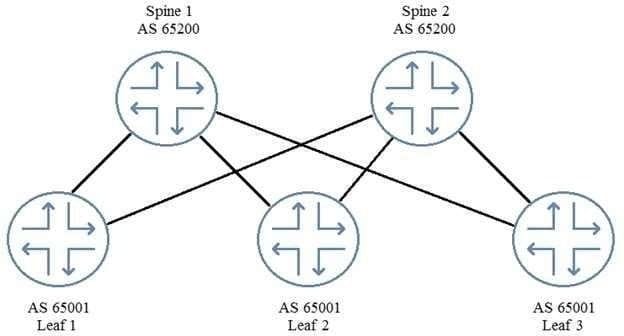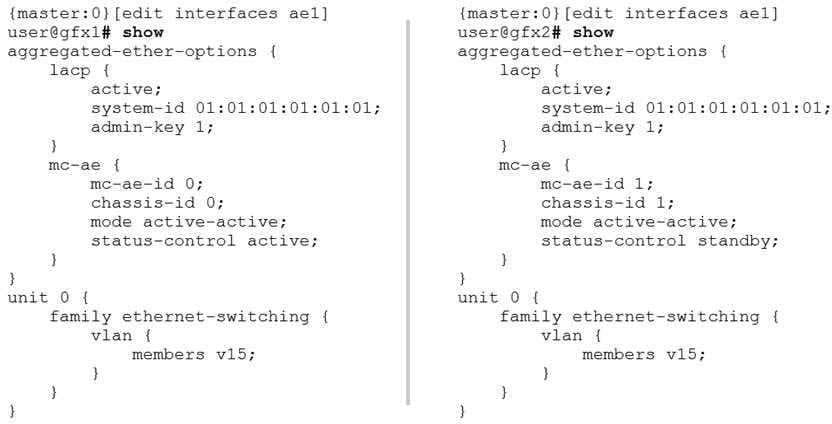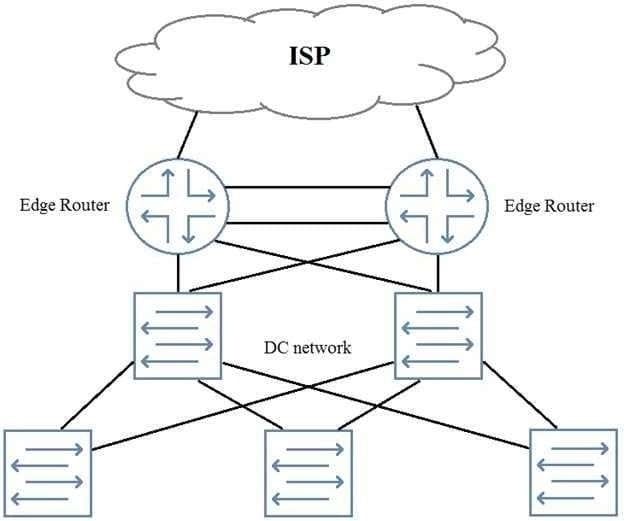Exam Details
Exam Code
:JN0-682Exam Name
:Data Center, Professional (JNCIP-DC)Certification
:Juniper CertificationsVendor
:JuniperTotal Questions
:130 Q&AsLast Updated
:Mar 27, 2025
Juniper Juniper Certifications JN0-682 Questions & Answers
-
Question 51:
Referring to the exhibit, not all routes are being exchanged by EBGP peers.

In this scenario, which BGP parameter would solve this problem?
A. mulcihop
B. mulcipach
C. mulcipach mulciple-as
D. as-override
-
Question 52:
Which two statements are correct about a spine and leaf-based IP fabric? (Choose two.)
A. Traffic is diverted within the fabric when a device or link fails.
B. There is no need for redundancy at the server level.
C. Leaf switches broadcast frames to all other leaf devices.
D. Clos networks demonstrate good scaling features.
-
Question 53:
Referring to the exhibit, each node in the IP fabric is peering to its directly attached neighbor using EBGP. Each node is peering using physical interface IP addresses. Leaf 2 and Leaf 3 are advertising the 10.1.1/24 network into EBGP. Spine 2 must be configured so that it can load- share traffic destined to the 10 1.1/24 network over both next-hop A and next-hop
A. Which two actions must be performed to accomplish this task? (Choose two.)
B. Use multipath multipath-As
C. Use multihop
D. Use advertise inactive
E. Use a load-balancing policy applied to the forward table
-
Question 54:
What are two types of EVPN routes? (Choose two.)
A. ES-lmport route target
B. Ethernet segment
C. MAC mobility
D. MAC advertisement
-
Question 55:
You have configured a new MC-LAG connection to a host. After committing the configuration, the MC-LAG link is not functioning properly.

Referring to the exhibit, how would you solve this problem?
A. Configure a system-id on qfx1 that is different from the system-id on qfx2
B. Change the mc-ae is on qfx1 to 1
C. Configure status-control on qfx2 to active
D. Change the chassis on qfx1 to 1
-
Question 56:
You need to add perimeter security to the network shown in the exhibit. All traffic must be inspected for attacks. The edge routers are using all available ports. Your solution must maintain both port and device resiliency.

In this scenario, which design would satisfy these requirements?
A. one-arm SRX Series chassis cluster
B. one-arm SRX Series device using LAG
C. inline SRX Series chassis cluster
D. inline SRX Series device using LAG
-
Question 57:
Which two statements are true about VRF routing instances? (Choose two.)
A. VRF can be used in conjunction with Layer 3 logical interfaces.
B. Each logical Layer 3 interface can belong to only one routing instance.
C. Each logical Layer 3 interface can belong to multiple routing instances.
D. VRF does not enable multitenancy.
-
Question 58:
You are asked to deploy an Ethernet bridging design in a data center with the following criteria:
-routing must occur on the leaf devices.
-VTEPs must terminate on the leaf devices.
-facilitate inter-VLAN communication.
-lower latency with East-West traffic.
Which architecture should you use in this scenario?
A. collapsed spine architecture
B. edge-routed bridging architecture
C. bridge overlay architecture
D. centrally-routed bridging architecture
-
Question 59:
You are deploying a 3-stage Clos IP fabric in your data center. In this scenario, which statement is correct?
A. Each server-facing interface on a leaf node is always three hops away from other server-facing interfaces.
B. Each spine node must be physically connected to all other spine nodes.
C. There is an eight-spine node limitation.
D. No direct physical connections exist between leaf nodes.
-
Question 60:
Which statement is true about a Data center interconnect over an IP network?
A. Layer 2 data must traverse a point-to-point
B. Layer 2 data must traverse an MPLS LSP.
C. Layer 2 data must be encapsulated.
D. Layer 3 data must be encapsulated
Related Exams:
JN0-102
Internet Associate, Junos(JNCIA-Junos)JN0-104
Junos, Associate (JNCIA-Junos)JN0-105
Junos, Associate (JNCIA-Junos)JN0-1101
Juniper Networks Certified Design Associate (JNCDA)JN0-130
Juniper networks Certified internet specialist.e(jncis-e)JN0-1301
Data Center Design, Specialist (JNCDS-DC)JN0-1302
Data Center Design Specialist (JNCDS-DC)JN0-1331
Security Design, Specialist (JNCDS-SEC)JN0-1332
Security Design, Specialist (JNCDS-SEC)JN0-1361
Service Provider Design Specialist (JNCDS-SP)
Tips on How to Prepare for the Exams
Nowadays, the certification exams become more and more important and required by more and more enterprises when applying for a job. But how to prepare for the exam effectively? How to prepare for the exam in a short time with less efforts? How to get a ideal result and how to find the most reliable resources? Here on Vcedump.com, you will find all the answers. Vcedump.com provide not only Juniper exam questions, answers and explanations but also complete assistance on your exam preparation and certification application. If you are confused on your JN0-682 exam preparations and Juniper certification application, do not hesitate to visit our Vcedump.com to find your solutions here.